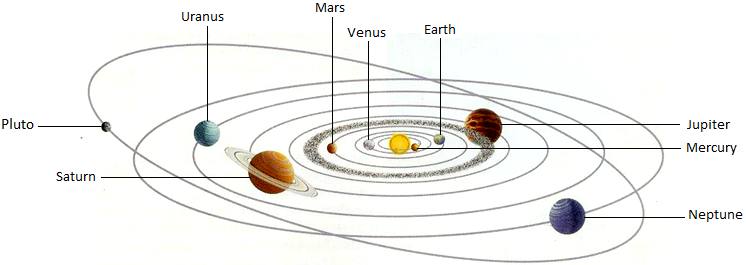Orbits of the Planets
We will discuss about the orbits of the planets. There are nine planets of the sun. They maintain their respective distances from the sun. They do not cross each other as they revolve around the sun remaining in their own orbits.
On the basis of their nearness to the sun they are Mercury, Venus, Earth, Mars, Jupiter, Saturn, Uranus, Neptune and Pluto.
The nearest planet to the sun is Mercury and the farthest, Pluto.
The largest planet is Jupiter. Then come Saturn, Uranus, Neptune, Earth, Venus, Mars, Mercury and Pluto in the descending order.
The four inner planets Mercury, Venus, Earth and Mars – which are closer to the Sun, are made up of rocks and iron.
Mercury
is the nearest planet to the Sun and it is very hot during the day and very
cold at night. It has no moons. There is very little air around mercury.
Venus is the hottest planet. It shines the brightest among all planets. It can be seen in the morning or evening. It is often called the morning or the evening star. Venus also does not have any moon.
Earth is the only planet that has life. It is neither too hot nor too cold. It has water and is surrounded by air containing oxygen.
Mars is known as the red planet. It appears red because of the red dust that covers it. It has two moons.
The outer planets are Jupiter, Saturn, Uranus, Neptune and Pluto. These planets are further away from the Sun. They are very cold and mainly consist of frozen gases.
Jupiter is
the largest planet. It has 16 known moons. It has a big red spot on it. This is
actually a huge storm which has been blowing for years.
Saturn is the second largest planet. It has 7 wide rings that surround it. It has 7 wide rings that surround it. It has 18 known moons.
Uranus is the third largest planet. It has 15 known moons.
Neptune has 8 known moons. Two spots can be seen on its surface. These are actually storms with very fast blowing winds.
Pluto is the smallest planet.
From Orbits of the Planets to HOME PAGE
Recent Articles
-
What Is Plasma? | Blood Plasma | Proteins | Nutrients | Cholesterol
Nov 07, 25 10:29 AM
Blood is a mobile fluid which is a connective tissue and is derived from the mesoderm like cell any other connective tissue. Colour of blood is reddish and that flows inside the blood vessels by means… -
Disorders of Respiratory System | Tuberculosis | Pleurisy | Emphysema
Oct 28, 25 11:39 PM
Tuberculosis is very common disease and is caused by a type of bacteria called Mycobacterium tuberculosis. This disease causes different trouble in the respiration and infection of several parts of th… -
Regulation of Respiration | Respiratory Centres | Inspiratory Area |
Oct 14, 25 12:13 AM
Respiratory Centre is the area that controls the rate of respiration and it is observed to be located in medulla oblongata and pons. Respiratory Centre has the following will dispersed components like… -
Explain Transport of Gases | External Respiration | Tissue Respiration
Oct 09, 25 11:35 PM
In humans gaseous exchange is completed in the following ways the steps are - External Respiration or Breathing - Breathing in false taking in of Oxygen and giving out of carbon dioxide in the body. M… -
Kind and Number of Teeth | Location of Teeth in Mouth | Care of Teeth
Sep 11, 25 12:52 AM
Kind and Number of Teeth






New! Comments
Have your say about what you just read! Leave me a comment in the box below.